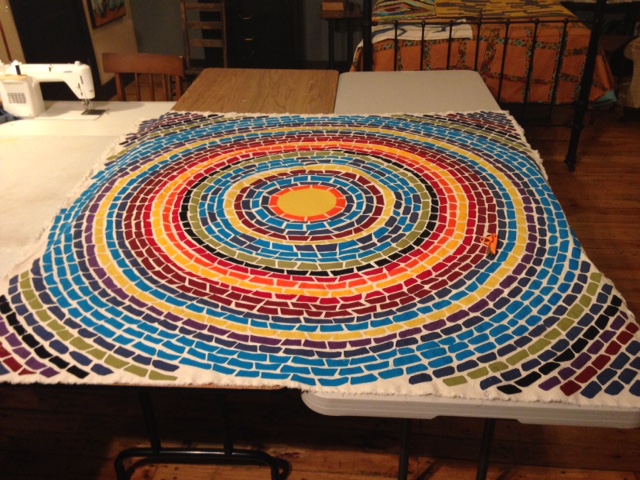I told you I'd be back with more details about the process of making this quilt whose "real name" is "Apollo Revisited: Homage to Alma Woodsey Thomas."
First, I'm very grateful to Florene Dawkins and Vivian Creighton Bishop for contacting me early enough so that I had plenty of time to experiment, think, experiment some more ... Florene first contacted me in June of 2015, and the event wasn't to be held until May of 2016, so I had almost a year to produce the quilt.
Second, I very much appreciate Florene and Vivian's giving me free rein to make whatever I wanted, so long as it was "inspired by the work of Alma Thomas." I understood that if the quilt were eventually gifted to the First Lady it would first have to have approval from them and their committee, of course, but they were very generous in their trust of me, and that trust was most helpful to my creative process.
I'm not much of a procrastinator, so I got started right away. First, of course, I took a very close look at Alma Thomas's body of work. So much good stuff!
I was particularly drawn to Thomas's circular pieces, in part, I think, because I knew that Michelle Obama must like them, her having chosen this one, "Resurrection," for the White House Dining Room:
Photo from ARTNEWS.
Isn't that beautiful? Google "Alma Thomas and White House" and you'll find more images of it. I think it's perfect for that spot.
My first thought was to replicate that very painting, "Resurrection," in fabric. But as I continued to study Thomas's work, I was more drawn to this one -- "Apollo Splashdown, 1970" --
Photo from MutualArts.com.
My attraction to this painting, and my interest in replicating it in fabric, had a lot to do with the fact that it features so much blue -- so many blues. I love blue, and I also thought that I might be able to use a good deal of denim, which for a number of reasons I love to use. One of those reasons is the fact that Columbus has, over the past 150 or so years, produced a great percentage of the world's denim. A second reason has to do with the fact that I now live and work in a loft apartment inside the building that once housed the mill that produced that denim -- Swift Manufacturing Company.
I experimented with a small piece that I made into a pillow:
While I liked the pillow fine, I thought that the tone, the value, of the denim wasn't as "bright" as what an Alma Thomas-inspired piece called for. Denim has a white thread in it, you know, and Thomas's colors are true and clear and bright.
So I ditched the denim idea and went with cotton duck, which comes in an array of full, bright colors.
Maybe I should back up and say that at first I experimented with "regular quilt fabrics," what we call Kona weight cottons. But they would have required precise piecing or applique, with clean, turned-under edges, and I thought that the canvas duck, with its strength and raw edges, better replicated Thomas's brush strokes.
Okay -- Now I'm gonna hush and just let you look at some photos of me at work. Except let me tell you one more thing -- Each and every piece of that canvas was individually cut out by me -- carefully, thoughtfully, with scissors -- and then, using a darning foot, sewn down to the canvas twice around. (After all, I didn't want Michelle Obama's quilt to fall apart!) That took a while, and some wrangling. I needed an intern to stand on the other side of the machine and help me wrangle. Fred did actually help with that a few times.
After I got all the "dots" sewn down (I did, literally, see them in my sleep!), I sandwiched the thing -- That is, I layered the completed top with a layer of batting (wool) and a backing -- and I started machine quilting -- in circles, 'round and 'round. I hand-quilted the center, though. Hand-quilting is really my thing, and while the canvas and duck were much too heavy and thick for hand-quilting the whole quilt, I did want to include a bit of hand-quilting -- so there it is in the center.
Finally, I bound the edges, added a label and hanging sleeve, and the finished quilt was ready to be submitted to committee. The date was July 31. I had spent two weeks in June experimenting, but by the first of July I had decided my materials and method and had begun work. I worked every day during the month of July -- four weeks -- several hours each day -- to complete the work. It was a labor of love.
My thinking was that if the committee didn't like the quilt I'd made, I had plenty of time to make another -- or another -- or another ... But they liked the first one, and it was eventually shipped to Washington for the event.
So now I really am gonna shut up and show you some photos:
Obviously, I didn't "primp" for the photos -- ha! I'm in work mode.
I worked from a glossy photo of Alma Thomas's painting, pictured in foreground.
The thing grew and grew ...
"Apollo Revisited: Homage to Alma Woodsey Thomas" by Cathy Fussell.








